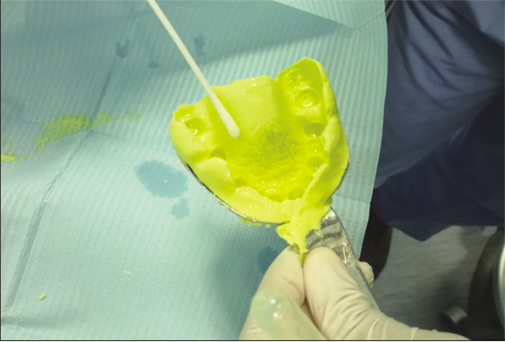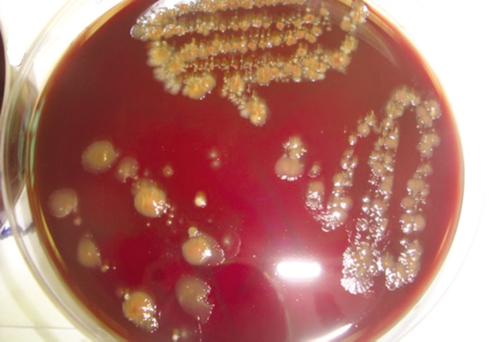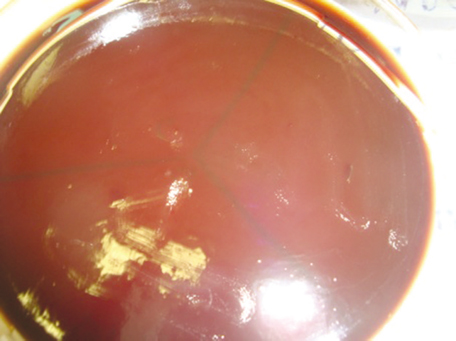J Adv Prosthodont.
2012 May;4(2):84-88.
Effect of alginate chemical disinfection on bacterial count over gypsum cast
- Affiliations
-
- 1Department of Prosthodontics, College of Dentistry, King Khalid University, Kingdom of Saudi Arabia. hb_satheesh@yahoo.com
Abstract
- PURPOSE
To evaluate the efficacy of sodium hypochlorite (1 : 10) and iodophor disinfectants on alginate impressions along with their effect on the survived bacterium count on the gypsum cast.
MATERIALS AND METHODS
Four alginate impression on each dentate patients were made, of which Group I were not washed or disinfected, Group II impressions were merely washed with water, Group III were disinfected by spraying with sodium hypochlorite (1 : 10), Group IV were disinfected with iodophor (1 : 213). Gypsum cast (type III) were made from all the impression. Impressions and gypsum cast were swabbed in mid palatal region for bacterial culture. Bacterial colony counting done after 3 days of incubation at 37degrees C in blood agar media. The data obtained was analyzed by one way ANOVA test at a significant difference level of 0.05.
RESULTS
Group I and Group II showed significantly more bacteria compared to Group III and Group IV. Bacterial colonies on the alginate impression and gypsum cast in group disinfected with Sodium hypochlorite (1 : 10) were 0.18, 0.82 respectively compared to group treated with iodophor (1 : 213). There was an increase in bacterial count on dental cast compared to source alginate impressions.
CONCLUSION
Sodium hypochlorite (1 : 10) was found to be better disinfectant for alginate impression. There was an indication of increase in number of bacteria from alginate impression to making of dental cast. Additional gypsum cast disinfectant procedures need to be encouraged to completely eliminate cross infection to dental laboratory.
Keyword
MeSH Terms
Figure
Reference
-
1. Connor C. Cross-contamination control in prosthodontic practice. Int J Prosthodont. 1991. 4:337–344.2. Leung RL, Schonfeld SE. Gypsum casts as a potential source of microbial cross-contamination. J Prosthet Dent. 1983. 49:210–211.3. Kugel G, Perry RD, Ferrari M, Lalicata P. Disinfection and communication practices: a survey of U.S. dental laboratories. J Am Dent Assoc. 2000. 131:786–792.4. Almortadi N, Chadwick RG. Disinfection of dental impressions - compliance to accepted standards. Br Dent J. 2010. 209:607–611.5. Powell GL, Runnells RD, Saxon BA, Whisenant BK. The presence and identification of organisms transmitted to dental laboratories. J Prosthet Dent. 1990. 64:235–237.6. Samaranayake LP, Hunjan M, Jennings KJ. Carriage of oral flora on irreversible hydrocolloid and elastomeric impression materials. J Prosthet Dent. 1991. 65:244–249.7. Jagger DC, Al Jabra O, Harrison A, Vowles RW, McNally L. The effect of a range of disinfectants on the dimensional accuracy of some impression materials. Eur J Prosthodont Restor Dent. 2004. 12:154–160.8. Martin N, Martin MV, Jedynakiewicz NM. The dimensional stability of dental impression materials following immersion in disinfecting solutions. Dent Mater. 2007. 23:760–768.9. Taylor RL, Wright PS, Maryan C. Disinfection procedures: their effect on the dimensional accuracy and surface quality of irreversible hydrocolloid impression materials and gypsum casts. Dent Mater. 2002. 18:103–110.10. Westerholm HS 2nd, Bradley DV Jr, Schwartz RS. Efficacy of various spray disinfectants on irreversible hydrocolloid impressions. Int J Prosthodont. 1992. 5:47–54.11. Bergman B. Disinfection of prosthodontic impression materials: a literature review. Int J Prosthodont. 1989. 2:537–542.12. Wakefield CW. Laboratory contamination of dental prostheses. J Prosthet Dent. 1980. 44:143–146.13. Jagger DC, Huggett R, Harrison A. Cross-infection control in dental laboratories. Br Dent J. 1995. 179:93–96.14. Jennings KJ, Samaranayake LP. The persistence of microorganisms on impression materials following disinfection. Int J Prosthodont. 1991. 4:382–387.15. Rentzia A, Coleman DC, O'Donnell MJ, Dowling AH, O'Sullivan M. Disinfection procedures: their efficacy and effect on dimensional accuracy and surface quality of an irreversible hydrocolloid impression material. J Dent. 2011. 39:133–140.16. Look JO, Clay DJ, Gong K, Messer HH. Preliminary results from disinfection of irreversible hydrocolloid impressions. J Prosthet Dent. 1990. 63:701–707.17. Infection control recommendations for the dental office and the dental laboratory. ADA Council on Scientific Affairs and ADA Council on Dental Practice. J Am Dent Assoc. 1996. 127:672–680.
- Full Text Links
- Actions
-
Cited
- CITED
-
- Close
- Share
- Similar articles
-
- Agar-alginate combined impression technique and dimensional change resulting from idophor disinfection
- THE EFFECT OF IMMERSION DISINFECTION ON THE DIMENSIONAL STABILITY OF RUBBER IMPRESSION MATERIALS
- COMPARISON OF THE ACCURACY OF STONE CASTS MADE FROM ALGINATE IMPRESSION MATERIAL BY MIXING METHODS AND APPLICATION OF TRAY ADHESIVE
- Evaluation of biogeneric design techniques with CEREC CAD/CAM system
- An Developmental Study of Artificial Skin Using the Alginate Dermal Substrate: Preliminary Report






